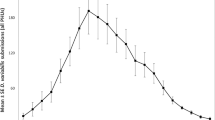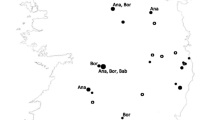Abstract
To determine the current distribution of bovine dermatophilosis in Zimbabwe, participatory rural appraisals were held at 36 locations in six districts. Results showed that bovine dermatophilosis is no longer confined to Hwange-Lupane area, but is now endemic in Gokwe, Sanyati, Kwekwe, and Kadoma. Virgin outbreaks of the disease were preceded by the appearance of Amblyomma variegatum ticks within an area. Spreading to new geographical areas (cited above) occurred during the liberation struggle (1975/79), droughts (1992/93, 1995/96), and of late, the land re-distribution exercise (2000–2002). Immediately after the war (1980/82), both the ticks and the disease were first cited in Gokwe whereas prior to that (1922–1980), both were confined to Hwange-Lupane area in the northwestern parts of Zimbabwe. Transmission from Gokwe to Sanyati, and from Sanyati to Chenjiri, occurred during the droughts of 1992/93 and 1995/96 respectively. In all the cases, the spreading of dermatophilosis was secondary to reduced tick control on cattle. The presence of dermatophilosis in the highveld (Kwekwe, Kadoma), a prime cattle production zone for the country, is a major threat to livestock production. These results have policy implications for tick and tick-associated diseases (dermatophilosis) control strategies for Zimbabwe.


Similar content being viewed by others
References
Ambrose, N. C., 1996. The pathogenesis of dermatophilosis. Tropical Animal Health and Production, 28, 29S-37S. doi:10.1007/BF02310696
Awad, W. S., Nadral-Elwgoud, M. I. Abdou. and El-Sayed, A. A., 2008. Diagnosis and Treatment of Bovine, Ovine and Equine Dermatophilosis. Journal of Applied Sciences Research, 44, 367–374.
Chatikobo, P., Kusina, N. T., Hamudikuwanda, H. and Nyoni, O., 2001. The effect of tick control on bovine dermatophilosis in a smallholder farming area of Zimbabwe. Zimbabwe Veterinary Journal, 32, 14–23.
Chatikobo, P., Kusina, N. T., Hamudikuwanda, H. and Nyoni, O., 2004. A monitoring study of the prevalence of dermatophilosis and parafilariosis in cattle in a smallholder farming area in Zimbabwe. Tropical Animal Health and Production, 363, 207–215. doi:10.1023/B:TROP.0000016833.27653.ba
Chatikobo, P., Choga, T., Ncube, C. and Muzenda-Mutambara, J., 2005. Participatory Rural Appraisals as an Epidemiological Tool in Animal Health Research: A Case Study of Sanyati and Gokwe Smallholder Farming Areas of Zimbabwe. Proceedings of the seventh symposium on science and Technology, l2, 197–208.
Dalis, J. S., Nwankpa, N. D., Okewole, P. A., Muhamad, L. M., Suleiman, l., Umar, U. and Umor, J. U., 2004. Risk factors associated with bovine dermatophilosis in the livestock investigation department, N. V. R. I, Vom, Nigeria (1991–1993). Proceedings of the 41st Congress of Nigerian Veterinary Medical Association, 46–47.
Dalis, J. S., Kazeen, H. M., Makinde, A. A. and Fatihu, M. Y., 2009. Distribution of lesions of dermatophilosis in cattle, sheep, and goats in Zaria and Jos, Nigeria. Journal of Animal and Veterinary advances, 82, 385–388.
Department of Veterinary Services (DVS), 2001 Department of Veterinary Services, Annual reports. Ministry of Lands, Agriculture and Rural Resettlement, Zimbabwe, 38–4.
Koney, E.B.M., Morrow, A.N. and Heron, I.D., 1996. The association between Amblyomma variegatum and Dermatophilosis epidemiology and immunology. Tropical Animal health and Production, 28, 18s–25s. doi:10.1007/BF02310694
Lawrence, J.A. and McKenzie, P.K.I., 1980. Isolation of a non-pathogenic Theileria of cattle transmitted by Rhippicephalus appendiculatus. Zimbabwe Veterinary Journal, 11, 27–35.
Morrow, A.N., Koney, E.B.M. and Heron, I.D., 1996. Control of Amblyomma variegatum and Dermatophilosis on local and exotic breeds of cattle in Ghana. Tropical Animal Health and Production, 28, 44s–49s. doi:10.1007/BF02310698
Statutory Instrument 250 of 1993. Animal Health (Cattle Cleansing) Regulations, 1993. Supplement to the Zimbabwean Government Gazette. The Government Printers, Harare. Zimbabwe, 1773–82.
Yeruham, I., Elad, D. and Perl, S., 2000. Economic aspects of outbreaks of dermatophilosis in first calving cows in nine herds of dairy cattle in Israel. Veterinary Record, 14624, 695–698.
Acknowledgements
This work was funded by the Department of Veterinary Services, Research and Diagnostic Brach, Government of Zimbabwe.
Author information
Authors and Affiliations
Corresponding author
Rights and permissions
About this article
Cite this article
Chatikobo, P., Choga, T., Ncube, C. et al. Bovine dermatophilosis, A re-emerging pandemic disease in zimbabwe. Trop Anim Health Prod 41, 1289–1297 (2009). https://doi.org/10.1007/s11250-009-9314-y
Received:
Accepted:
Published:
Issue Date:
DOI: https://doi.org/10.1007/s11250-009-9314-y




